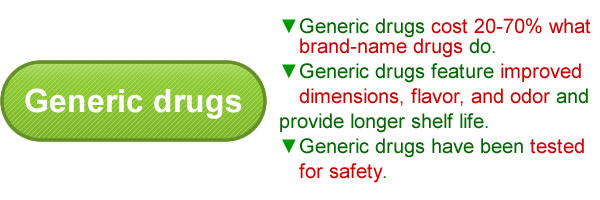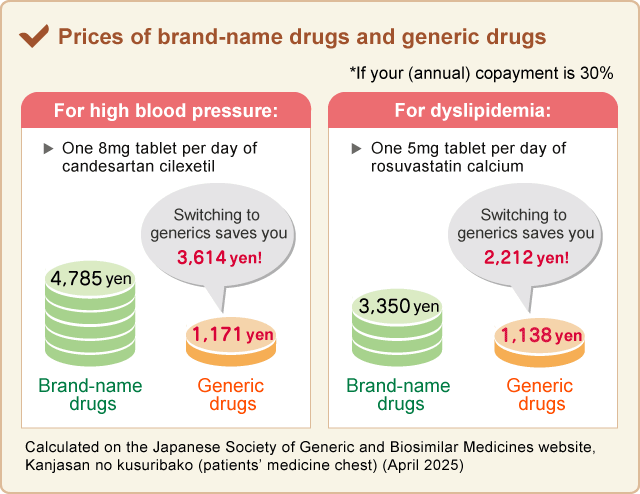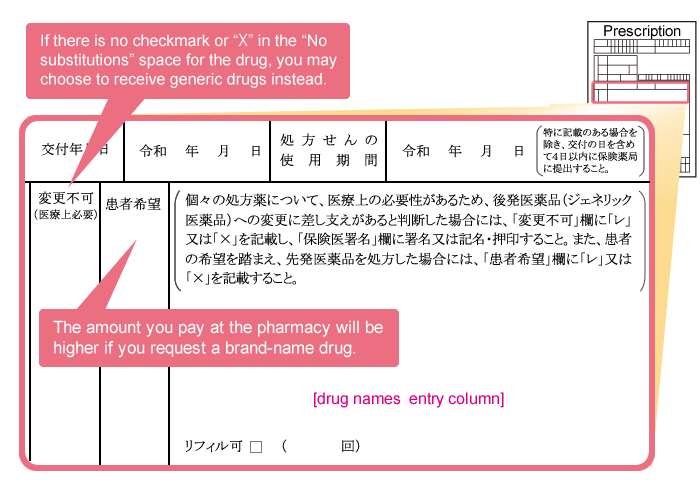Using generic drugs
National medical care costs continue to rise year after year. “Generic drugs” are one solution expected to help hold down medical care costs. Switching from brand-name drugs to generic drugs is also easier on household budgets and should contribute significantly to cutting medical care costs. Be sure to read all the information provided below to ensure a proper understanding of the benefits of generic drugs, then use them to save on medical care costs.

What are generic drugs?
As you may have gathered from television ads, generic drug are drugs introduced after the period of exclusivity of brand-name drugs (i.e., the term of the drug patent, in principle 20-25 years) has expired. Featuring the same active ingredients as brand-name drugs, they are available at lower cost due to lower development costs.
What is an authorized generic (AG)?
Authorized generics are generic drugs that have not only the same active ingredients but also feature the same bulk drug substances, additives, manufacture methods, and other properties as brand-name drugs.
These drugs are called authorized generics (AG) because they are authorized by the manufacturers of brand-name drugs.
Ordinary generics may feature different bulk drug substances, additives, manufacture methods, or manufacturing plants from brand-name drugs. In contrast, authorized generics are offered as generic drugs that are identical to brand-name drugs, with the authorization of the brand-name drug manufacturers.
| Brand-name drugs | Authorized generics | Ordinary generics |
|---|---|---|
| Active ingredients | Same | Same |
| Bulk drug substances | Same | May differ |
| Additives | Same | May differ |
| Manufacture methods | Same | May differ |
| Manufacturing plants | Same (may differ in certain cases) | May differ |
| Efficacy and effects | Same (not including indications subject to reexamination*) | Same (not including indications subject to reexamination* during patent period) |
- * Reexamination: Examination to confirm efficacy and safety after approval of a brand-name drug
Distinguishing features of authorized generics
For both doctors and patients, authorized generics more closely resemble brand-name drugs than do ordinary generic drugs. Additionally, manufacturers may be able to bring authorized generics to market faster than ordinary generic drugs.
What is a biosimilar?
The active ingredients (ingredients with therapeutic effects) of biomedicines are proteins produced using the power of cells, microbes, and other biological organisms.
Biosimilars are drugs sold by other pharmaceuticals companies after the patents of biomedicines have expired. They can be used in the same way as drugs whose patents have expired. In principle, they are priced at 70% of brand-name biomedicines.
How do biosimilars differ from generics?
Since the active ingredients of biosimilars are complex proteins, it is difficult to produce exactly the same drug as the one whose patent has expired. Accordingly, biosimilars are checked to confirm that their efficacy and safety are equivalent to brand-name biomedicines, even if they differ slightly in structure. To do this, they require extensive testing, and are handled under a different system from generic drugs due to these differences.
Benefits of choosing generic drugs
Switching from brand-name drugs to generic drugs can lower what you pay at the pharmacy. While this may not amount to much for medicines taken over a short period of time, like cold medicines, it can cut drug costs significantly for people who require medicines over extended periods to treat chronic conditions like dyslipidemia, high blood pressure, or diabetes.

- ** The amounts shown in the table are drug prices for reference purposes only. The actual amount the patient pays at the pharmacy will include other costs, such as the dispensing technical fee and pharmacy admin fee.
Click here to determine how much you could save by switching drugs you normally take to generics.
- Reference link:
How to switch to generic drugs
Start by asking your doctor
Ask your doctor if you are currently undergoing treatment and have not yet switched to generic drugs. Whatever reluctance you might feel in asking such a question, simply asking “Can I use generic drugs?” can cut your drug costs dramatically. With prompting from the Ministry of Health, Labour and Welfare of Japan, growing numbers of medical care institutions are taking active steps to encourage the use of generic drugs. Don't be afraid to ask.
Check “the No substitutions” space on your prescription
In the previous format used for prescriptions, your doctor needed to sign or affix a seal to prohibit all substitution of generic drugs. This meant that even if you were prescribed multiple drugs, if your doctor signed or affixed a seal to the prescription to indicate no substitutions, switching to generics was not possible for any of the drugs prescribed. In April 2012, the format changed to one that allowed generic substitution for each drug, making it easier to switch to generics.
However, some brand-name drugs still lack generic equivalents. If you are having a prescription filled at a pharmacy outside the hospital for currently ongoing treatment, have the pharmacist check to see if any generic drugs are available to substitute for brand-name drugs. Some doctors are cautious about switching to generic drugs if the patient's condition is stable, based on the belief that would be better to stick with the brand-name drugs already proven effective up to that point.
In such cases, the doctor will instruct the pharmacist not to change the drugs prescribed-for example, by checking or placing an “X” in “the No substitutions” space on the prescription. As long as no such restrictions are indicated for the drug, the patient is free to switch to generic drugs as he or she sees fit.

You can also try switching to generics temporarily
If you are worried about switching suddenly to generic drugs, you can split the number of days of the prescription. For example, for a four-week prescription, you can have the prescription filled for just the first week, then have the prescription for the remaining three weeks filled if there are no problems with the medicine. (This is called split dispensing.) When you use this split prescription system to try switching to generic drugs, the split dispensing fee will be added for only the second time the split prescription is dispensed. Ask your pharmacist for more information.
Your copayment may be higher if you request a brand-name drug for which generic drugs are available
From October 2024, for certain drugs, a surcharge equal to one-fourth of the difference in drug prices will apply if you request a prescription for a (long-listed) brand-name drug for which generic drugs are available.
We encourage you to take this occasion to start making active use of generic drugs.
Surcharge applies to either of the following brand-name drugs:
- Brand-name drugs for which equivalent generics were first listed on drug price standards five or more years ago (excluding those for which the rate of generics substitution is fewer than 1%).
- Brand-name drugs for which equivalent generics were first listed on drug price standards less than five years ago but for which the rate of generics substitution is 50% or more.
- * This excludes a case in which your doctor or dentist identifies a medical need to prescribe or administer brand-name drugs.
Try using “a generic drug request card”
When you visit a medical care institution or get a prescription filled at a pharmacy, you can present this card to make it easier to indicate your preference for generic drugs.
